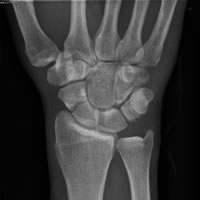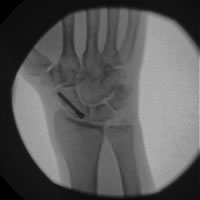Conditions Treated
Scaphoid Fracture and Non-union
What is it?
The scaphoid bone is one of the 8 bones in the hand. It is the shape of a kidney bean and about 4 times the size. It is a very important bone as it transmits the majority of force across the wrist joint, allowing a good, stable and strong range of movement.
What causes it?
The scaphoid bone is the most commonly damaged bone in the hand. Fractures occur following a fall onto the outstretched hand, usually during sporting activities such as snowboarding or skiing.
What is non-union?
The scaphoid is an unusual bone as the vast majority of it is covered in cartilage because of this has a very poor blood supply. In order for fractures to heal, they require a good and constant supply of oxygenated blood. The trauma of the fracture can disrupt the blood supply meaning that some parts of the bone don't receive a good blood supply. This can lead to fracture healing being delayed and in some cases the fracture fails to heal at all. This is known as non-union.
Patients who smoke and have other medical conditions affecting their ability to heal are more prone to non-union.
In some cases the blood supply to the fractured scaphoid fragments is so poor that the fragments die, this is know as AVN or avascular necrosis.
What are the symptoms?
The majority of patients present following a history of a fall on to an outstretched hand. They will complain of pain and swelling around the wrist and the base of the thumb.
Patients with non-union generally present with similar pain that has failed to settle in the usual way following a fall. Some patients may present with symptoms of wrist arthritis (link to wrist arthritis page) with a history of a "wrist sprain" or minor trauma many years before that settled but has then recently reoccurred.
Do I need any further investigations?
YES. All patients will need x-rays to assess whereabouts in the scaphoid is and how displaced the fragments are. Patients with a non-union require both CT and MRI scans to assess the degree of fracture healing and the blood supply to the fracture fragments.
What is the treatment?
In acute fractures, treatment depends on the position of the fracture in the scaphoid and the position of the fractured bone fragments.
- Simple, un-displaced fractures are treated in a below elbow plaster for 6-8 weeks followed by hand therapy.
- Simple, minimally displaced fractures may be better managed with a small operation through a 1cm incision on the back of the wrist to place a screw across the fracture and compress the fragments together. The advantage of this is that patients spend less time in plaster and the rate of fracture healing is slightly higher.
- Complex, displaced fractures require open surgery to realign the fragments and stabilize them with a screw. This is done through an incision on either the back or front of the hand/ wrist.
- Non-unions are complex to treat and if left, there is a high risk of developing wrist arthritis (Link to writ arthritis page). Following investigation, patients require an open operation to realign the fracture fragments. At the same time Mr. Hacker will take a bone graft from the pelvis (the boney bit where your belt sits) and place this in the gap formed by the non-union. The scaphoid and bone graft are then compressed with a special screw. This process helps to stimulate the fracture to heal.
How long will it take to recover?
- Simple/un-displaced fractures - most patients recover following plaster cast immobilization for 6-8 weeks. Most have some residual stiffness for 3-6 months, which slowly recovers with hand therapy.
- Simple/ Minimally displaced fractures - most patients are treated in a temporary plaster splint for the first 2 weeks. After that, you will be fitted with a custom made plastic splint and allowed to get your wrist going gently.
- Complex/ Displaced fractures - most patients recover following plaster cast immobilization for 6-8 weeks. Most have some residual stiffness for 3-6 months, which slowly recovers with hand therapy.
- Non unions - most patients recover following plaster cast immobilization for 6-8 weeks. Most have some residual stiffness for 3-6 months, which slowly recovers with hand therapy. Patients often complain of more discomfort around the hip wound than the wrist. This does settle with time.
What are the potential complications?
Any surgical procedure carries risks, however every effort is made to minimize these to ensure the best possible outcome from your surgery.
- Infection - Uncommon and usually treated very successfully with antibiotics
- Delayed/Non union - in patients who smoke or with other medical problems, fracture may be slow to fuse or may not fuse at all. If this is the case, further immobilization in plaster or other operations may be required.
- Painful/Tender Scars - the vast majority of patients complain of some discomfort around the scar and thumb, this is know as pillar pain and generally resolves with time. Rigorous wound care and desensitization as directed by your hand therapist help prevent this.
- Damage to nerves and tendons - this occurs in less than 1% of patients and may require surgical repair.
- Stiffness - Operations to the hand may cause stiffness, this can be minimized by working closely with your hand therapist and getting your hand moving as early as possible.
- CRPS - An uncommon but potentially serious complication of hand surgery leading to pain, swelling and discomfort. It is impossible to predict this problem but working closely with you hand therapist and getting your hand moving early has been proven to significantly reduce the risk of this.
When can I get back to normal activities?
This depends on the type and extent of treatment carried out.
The hand MUST be kept clean and dry for 10 days until the sutures are removed. Depending the site and extent of your surgery you should be able to return to "desk job" type activities within 1-3 weeks of the operation.
Any manual work, heavy lifting or sporting activities should be avoided for at least 2-8 weeks.
You may return to driving in around 1-6 weeks. Please inform your insurance company that you have recent hand surgery to ensure that are happy for you to do so.


